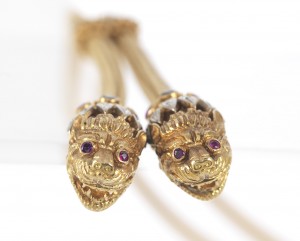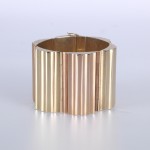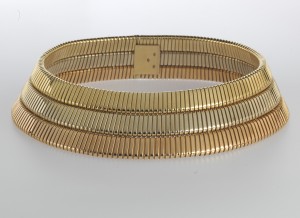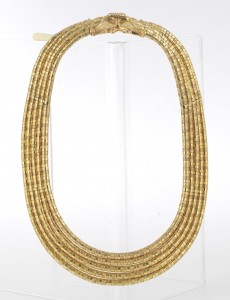The Late Bronze Age Shannongrove Gorget in the Victoria and Albert Museum in London attracted Astrid Fialka-Herics’s attention and led her to the subject of gold, probably the most sought-after precious metal of all times.
Gold is not only a precious metal that has retained its significance in all cultures for thousands of years; it is also a symbol of power and greatness, of earthly riches and divine wisdom, offering a visual demonstration of skilled workmanship and tradition, and also serving as a highly reliable and stable form of currency.

Early civilisations and the Bronze Age
Jewellery in Neolithic cultures had a religious significance: amulets and talismans accompanied the dead on their journey to the beyond, and gold was used only occasionally for decoration or refinement. Making pieces of jewellery entirely out of gold was revolutionary, as basic materials like bone, stone or wood were completely replaced by the precious metal.
In the region between the Euphrates and the Tigris, the Sumerians, Akkadians, Babylonians and Assyrians had already mastered various processing techniques by 3500 BCE: bending, chasing and engraving techniques were used to make head and neck jewellery, rings, bracelets and breastplates.
In the Early Bronze Age the handicraft skills were refined through the introduction of filigree and granulation techniques. Jewellery items now also included earrings, diadems, needles (brooches) and sealing rings.
Shannongrove Gorget
The collar in the Victoria and Albert Museum, named after the bog where it was discovered, was made in Ireland in the Late Bronze Age between 800 and 700 BCE. It bears witness to the outstanding skill and sophisticated craftsmanship that had spread over the centuries from the southern Mediterranean through the Middle East to Northern Europe. The ornaments are a graphic example of the granulation technique, in which a surface is covered with spherules without the use of solder. The difficulty is in joining the two metals without scorching them.
Although Ireland was known to have not only copper but also numerous gold deposits at the time and most gold objects came from Ireland, according to recent research many of these Irish pieces were made of gold from Cornwall or the South of England. It would appear that Irish gold was used for preference as a currency rather than as a material to be worked.
Middle Ages
Whereas goldsmiths originally worked for the court or church, in the Late Middle Ages they began to gain their independence. Their clients were rich burghers, whose taste was reflected in precious works. Jewellery supplemented or replaced imperial and sacral objects.
The craftsmanship and also the theoretical knowledge of the metal’s secrets, often closely linked with alchemy, were passed on from generation to generation. Over the course of the centuries, jewellery and decorative objects of inimitable precision were created in this way. Even the possibility of making gold redder through the addition of copper or whiter through the addition of silver was known to the master goldsmiths of the time.
20th century

In the 20th century, international concerns like Cartier or Bulgari developed their brands by combining the different colours of gold in individual pieces of jewellery.
Distinctive forms highlight the colour contrast, made highly visible through new processing techniques – like Tubogas bands used to make serpentine bracelets or necklaces.
The fascination of gold in its various forms and colours continues to inspire artists and delight wearers.


Gold 750, Length c. 49 cm
Estimate € 11,000 – 14,000
Jewellery auction 21 April 2016

Jewellery auction in April
21 April 2016, 2 pm
Exhibition 9 – 21 April 2016
Palais Dorotheum
view the Online Catalogue
Jewellery auction in June
2 June 2016, 2 pm
Exhibition 13 May – 2 June 2016
Palais Dorotheum
The Shannongrove Gorget, image above
Embossed gold collar, Ireland, late Bronze Age (probably 800 – 700 BC),
Given by Col. C. K. Howard Bury
© Victoria and Albert Museum, London











